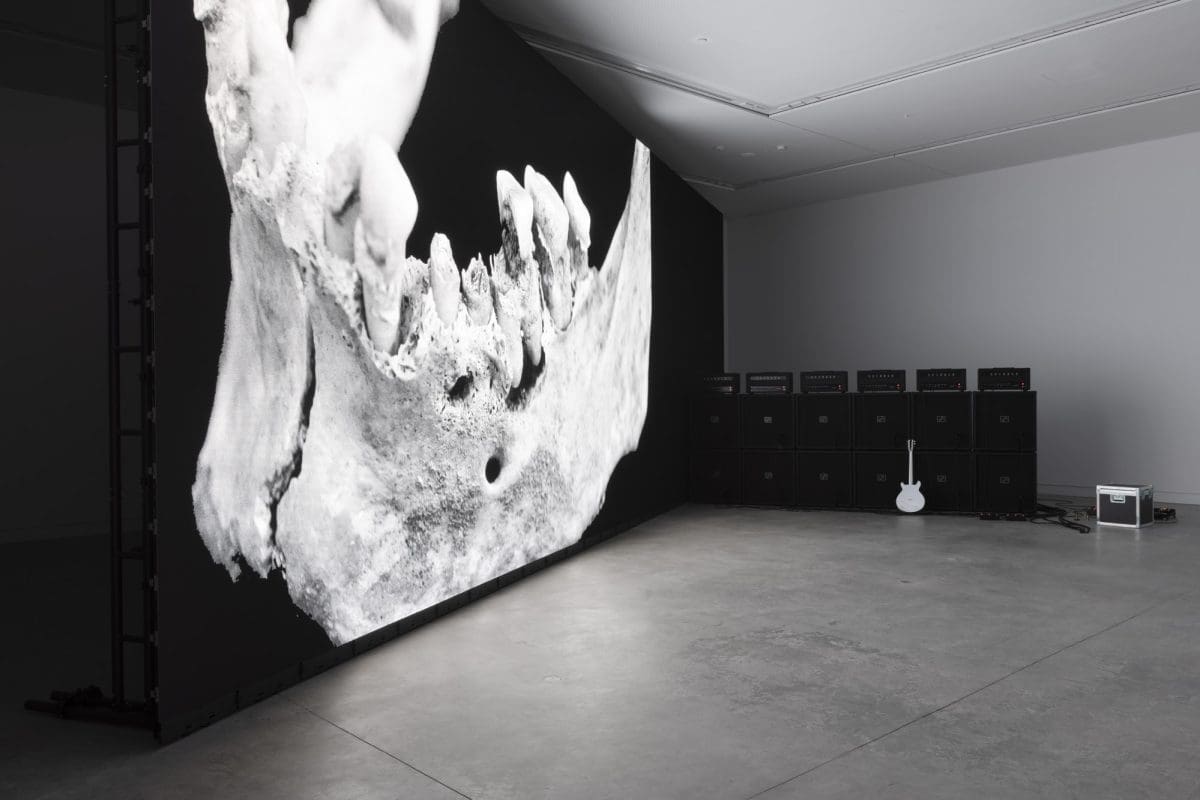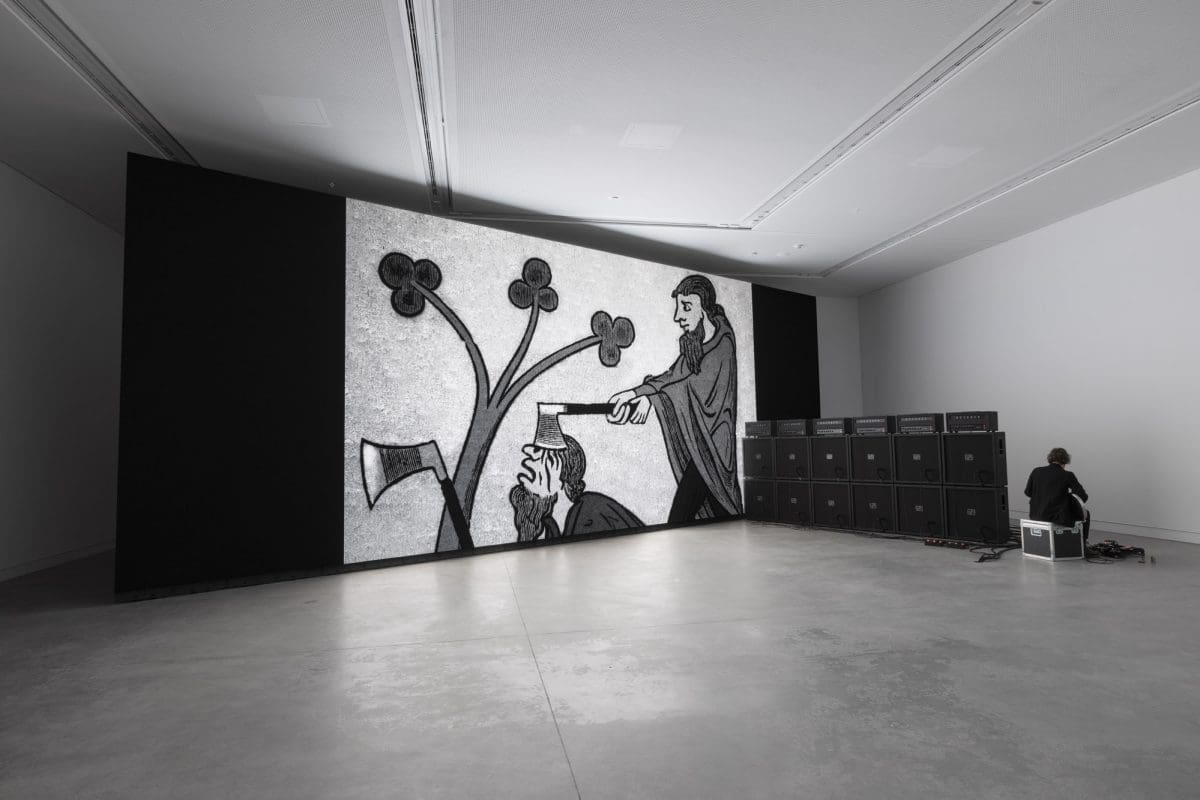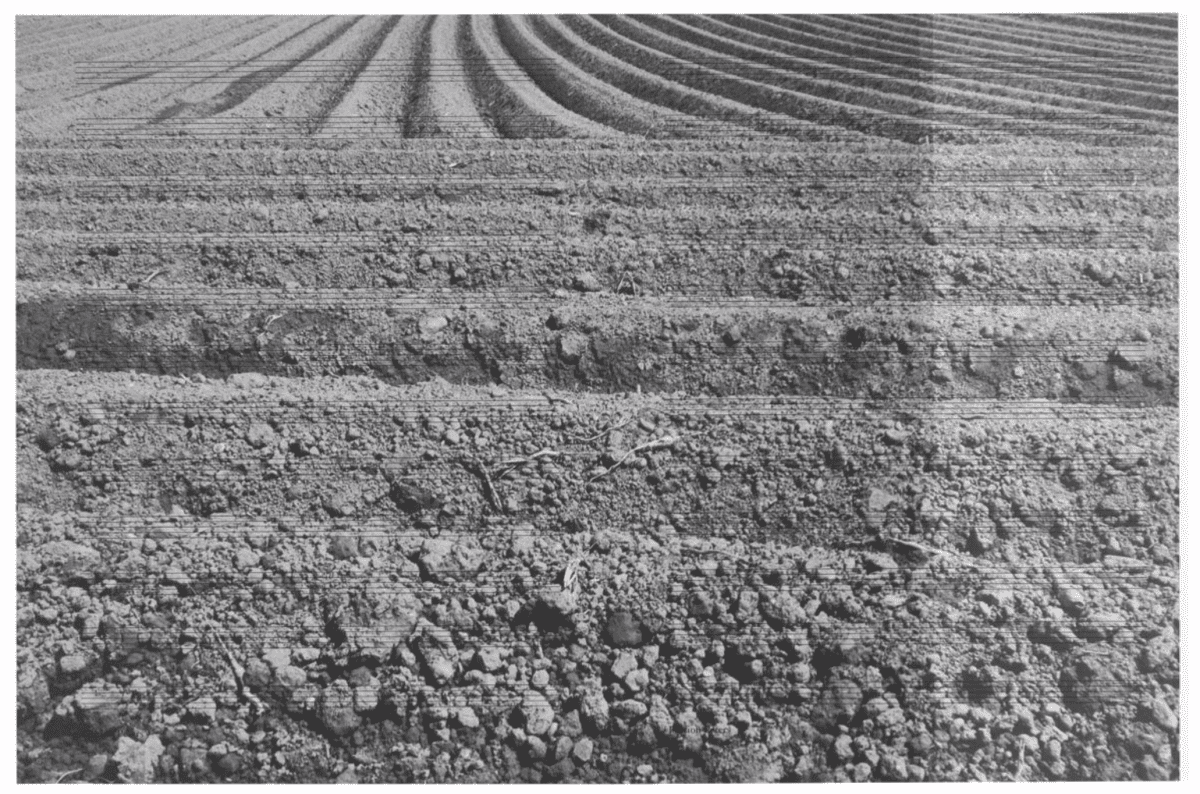
Piercing the veil
A new exhibition at Buxton Contemporary finds a rich complexity in the shadowy terrain between life and death.

Marco Fusinato, DESASTRES, 2022, solo durational performance as installation 200 days. Installation views, Australia Pavilion, 59th International Art Exhibition of La Biennale di Venezia, 2022. Photographer: Andrea Rossetti.

Marco Fusinato, DESASTRES, 2022, solo durational performance as installation 200 days. Installation views, Australia Pavilion, 59th International Art Exhibition of La Biennale di Venezia, 2022. Photographer: Andrea Rossetti.

Marco Fusinato, DESASTRES, 2022, solo durational performance as installation 200 days. Installation views, Australia Pavilion, 59th International Art Exhibition of La Biennale di Venezia, 2022. Photographer: Andrea Rossetti.

Marco Fusinato, selection of pages from the Score for DESASTRES, 2022, facsimile on Edition Peters manuscript paper, each 30.3 x 45.5 cm. Courtesy of the artist and Anna Schwartz Gallery.

Marco Fusinato, selection of pages from the Score for DESASTRES, 2022, facsimile on Edition Peters manuscript paper, each 30.3 x 45.5 cm. Courtesy of the artist and Anna Schwartz Gallery.
Noise and silence, underground and institution, maximalism and minimalism: for three decades Marco Fusinato has worked across his noise guitar performances, installations, and appropriated musical scores. Interrogating moments of extremity, whether political or musical, Fusinato is now representing Australia in the 2022 Venice Biennale with DESASTRES, a guitar and image-based performance by the artist every day of La Biennale Arte 2022—200 days in total.
Bringing together swathes of art-historical and cultural references DESASTRES is both a conceptual and body-focused performance, Audiences can engage with DESASTRES digitally via Instagram @desastres_desastres, desastresdesastres.com, and a livestream from Saturday 23 April 2022.
Here, Fusinato talks to Art Guide about punk, noise and music, and moments of radicalism.
Tiarney Miekus: What music did you listen to growing up?
Marco Fusinato: The first music I became interested in was the first wave of punk. At the time when I was growing up a lot of guys around me were listening to AC/DC, Led Zeppelin, Deep Purple, all that kind of stuff, which I could never connect with. As a wog growing up in the suburbs, it was like the skips that listened to that music, they’d hang out at the milk bar and pick on us. I really didn’t like what those bands represented and still don’t. When punk came along, I was completely into it. I found the satirical content of the lyrics, the raw sound, and, most importantly, the things spoken about in interviews really important. For example, I was into The Clash and in their interviews they didn’t speak about fast cars and girls, they spoke about social change, Marxism, terrorism—and that led down the path of wanting to find out more. It wasn’t just the music, it was the whole philosophical bent behind it. I was interested in a particular moment with The Clash, their first two records. After that I really got into Crass, the English anarchist band. Their whole ethos, the lyrics and what they sang about, the packaging and design, and the rawness of the music: it was exciting.
TM: Did you dress like a punk?
MF: I remember I came home with ripped jeans, the whole look, and the next day the jeans were perfectly patched up by my mother—classic Italian family, right. And she said to me, “You’re not walking around in ripped jeans because you don’t know what poverty is and you’re embarrassing yourself.” My parents came from a lineage of Contadini which is a form of pre-industrial agricultural farming; like peasants, really poor, and they suffered through the Second World War and migrated to Australia. They’d experienced extreme poverty. Mind you, I’m growing up and living in a lower socioeconomic working class suburb, everyone’s parents that I knew were migrants working in factories—so it’s like the perfect context to be punk, but my mother turns around to me and says, “You’re not going out dressed like that because you don’t know what poverty is.” And I kind of got it. I also never embraced the look because it was pretty rough where I grew up and if you stood out you were going to get beaten up. It was too much of a risk, so it became more a philosophy rather than a lifestyle.
TM: That’s a good early lesson in how the image of radicalism or punk doesn’t always match up with the politics of that thought.
MF: It’s so true. A lot of the thinkers I admire look like accountants, and yet their minds are radical. It was a really good lesson that you don’t have to have that outward show to forge your identity. You can do it in other ways.
TM: I know you never learnt guitar in a traditional way and don’t have musical training, but have you ever tried to learn, or is it more a case of purposefully not learning?
MF: I’ve had moments when I’ve tried. I remember going into music shops and there were books on how to play in the style ‘so-and-so famous guitarist’. And I realised that no matter how much I would try, I could never do it. I didn’t have the ear, I didn’t have the patience, I didn’t have the technical ability. It made me realise though that there’s no section in the shop that says how not to play the style of so-and-so: how not to play like Jimi Hendrix. You have to understand and embrace your limitations and develop your own language in a way that works for you. So, the approach to guitar was always a conceptual approach as opposed to a technical one.
And going back to that early punk stuff; I’m a collector of records and from early on I was into collecting bootleg recordings. The bootleg tapes were especially interesting because they were copies of copies of copies of copies. They sounded more like noise records due to the degradation of the tape and the consequent hissing.
TM: You make noise as music, but I find many people still hold a noise/music divide. Do you find that too?
MF: My take is that I’m using musical instruments, I may use them unconventionally, but I’m using musical instruments and whatever comes out from them I consider to be music. It’s as simple as that. If I was using non-musical instruments, let’s say a garbage can and rocks, maybe I’d think about it differently, but I’m not. I’m using a guitar and an amplifier. I’m using those instruments on purpose as signifiers. The guitar has a very specific role in culture, it’s capitalism’s entertainment tool and sells all types of commodities. So that’s certainly one of the reasons why I enjoy using it: to defy expectations and make something confounding with it and take it elsewhere.
TM: As much as there’s a trope of the rock star and his guitar, I think there’s also a trope of the noise guitarist and his guitar. Is that something you think about?
MF: It’s about doing what you’re comfortable with and being genuinely ‘into it’, but I’m aware of the baggage that goes with it. My approach is that my moment on earth is between the mid-1960s through to, say, 2040 maybe. I will be defined by this thing called ‘contemporary art’ and ‘experimental/noise music’. So if I take a macro view of my lifetime, the question is; what’s the predominant instrument of the culture I’m surrounded by? The electric guitar is one, if not the, most popular instrument of that time. Like, looking back at the Renaissance, it was defined by the lute. Or looking back at the late 19th century with the piano. Going back through art history you can see why artists were using certain materials at a certain time, because it was the technology of the day. I’ve used the guitar and been interested in its status for a long time, and I’m thinking of it ‘macro-ly’—there’s a word I’ve invented.
TM: With your guitar performances, you’ve talked about them as “sculpting in the air with noise”. Can you unpack that?
MF: Moving air equals vibrations. And when you’re using a powerful amplification, then you feel it. I’m interested in feeling it as much as hearing it. It’s a bodily experience. When I’m performing, I’m right next to the amplification, so I really feel it. The air is moving, my pants and shirt are flapping. Certain frequencies accentuate that, so I use that to affect. At times, cutting to silence creates a massive dynamic shift and everything disappears. When I’m talking about sculpting air it’s about trying to mould and shape the experience.

TM: In your work Constellations there’s a baseball bat chained to the gallery wall and viewers hit the bat against the wall, emitting a huge sound from hidden microphones. What made you give the act of performance to the viewer?
MF: I’ve done that a few times. There’s also a series called Aetheric Plexus which takes the infrastructure from staging—the lighting, the rigging, and so on—and I make it into a large sculpture that unleashes a barrage of white noise and white light onto the audience. The audience triggers the assault through a hidden sensor, and in turn they become the performer and it’s their reaction that’s the feature of the work.
Constellations came out of seeing violence on television, on screens and how it’s so mediated. The baseball bat and the chain are synonymous with on-screen violence. It’s an action most people don’t experience or hear in real life. I wanted to bring that into the gallery, to see how people would interact with it as a study of behaviour. The purpose-built wall is free standing and it diagonally bisects the space. One side of the white wall is blank, minimal; the other side has the chain and bat coming out. What the audience doesn’t realise is that there’s a hidden PA system inside the wall that amplifies their action at 120 dB. Over time one side of the wall is covered in thousands and thousands of dents, or ‘constellations’. My idea of activating the audience is to remind them that they’re alive.
TM: Can we talk about the Mass Black Implosion drawings. I’m curious how they came about because it seems inspired to rethink both classical and experimental musical scores by drawing lines from all of the notes to one single point and sound.
MF: I was thinking about composers of contemporary composition, and their pursuit of trying to push the language of what music can be. A lot of these composers invent their own methodology for notation, like graphic scores for example. The first composer’s scores I started with, and was the catalyst for the series, was one by Iannis Xenakis, who wrote in sound masses. The title came from an amalgam of Xenakis’s Masses and Masayuki Takayanagi’s Mass Projections, compressed by death/ black metal syntax. The idea with the series was to take scores and reduce them to pure noise. I’d select the score and then have it reproduced at one-to-one scale. I’d then choose a point arbitrarily on the score and rule a line from every original note back to that point, as a proposition for a new composition in which every note was played at once, as a moment of singular impact. It’s an ongoing series and I do them in bursts when time permits because it’s quite a big process that involves many people.

TM: You said about Mass Black Implosion that “there’s an allure and beauty with the object, but what it proposes is menacing”. That dichotomy in your work makes sense to me.
MF: It’s central to what I do. Everything is based around this idea of looking at the tensions around opposing forces: order and disorder, the institution versus the underground, noise versus silence, purity versus contamination.
TM: Many artists talk about working within such binaries or trying to unpack them. But I like how you keep things in tension, like maximalism and minimalism, or noise and silence. You acknowledge that binaries exist instead of flaking them off as arbitrary.
MF: Exactly. That’s the friction I want to work with and maintain. I don’t want to get rid of one or the other, they coexist. I feel like that’s the closest thing to life too, that you have to exist with that and learn how to deal with it. All those forces are always rubbing up against each other and how we deal with it is the interesting thing.
TM: In interrogating acts of radicalism or moments of extremity—whether it’s the single point in Mass Black Implosion, or the images of 21st-century protestors in The Infinitives series—you get to an absolutely precise moment of radicalism or potential. What do you find compelling about that moment?
MF: It goes back to that friction. It’s like barricades, there’s something on one side, and something on the other, and I’m interested in that bit in the middle. Like the divide between the stage and the audience, that’s a really fascinating area to occupy and to see both sides. Or the tension between the underground and the institution… bringing one into the other and working with the contradictions and conflicts that arise. I like how one shouldn’t belong with the other. But what happens if you play with that? I feel it’s to do with some kind of power relationship and it’s those agitations that I’m interested in. It’s like, I’ll go to Noble Park to do the shopping for my mother during the day, and then that evening I’ve got a dinner with super rich people. It’s like class war but it’s still me occupying those opposites.
Venice Biennale 2022
Venice, Italy
23 April—27 November 2022
Instagram: @desastres_desastres
desastresdesastres.com
Livestream on Saturday 23 April 2022
This article was originally published in the November/December 2021 print edition of Art Guide Australia.